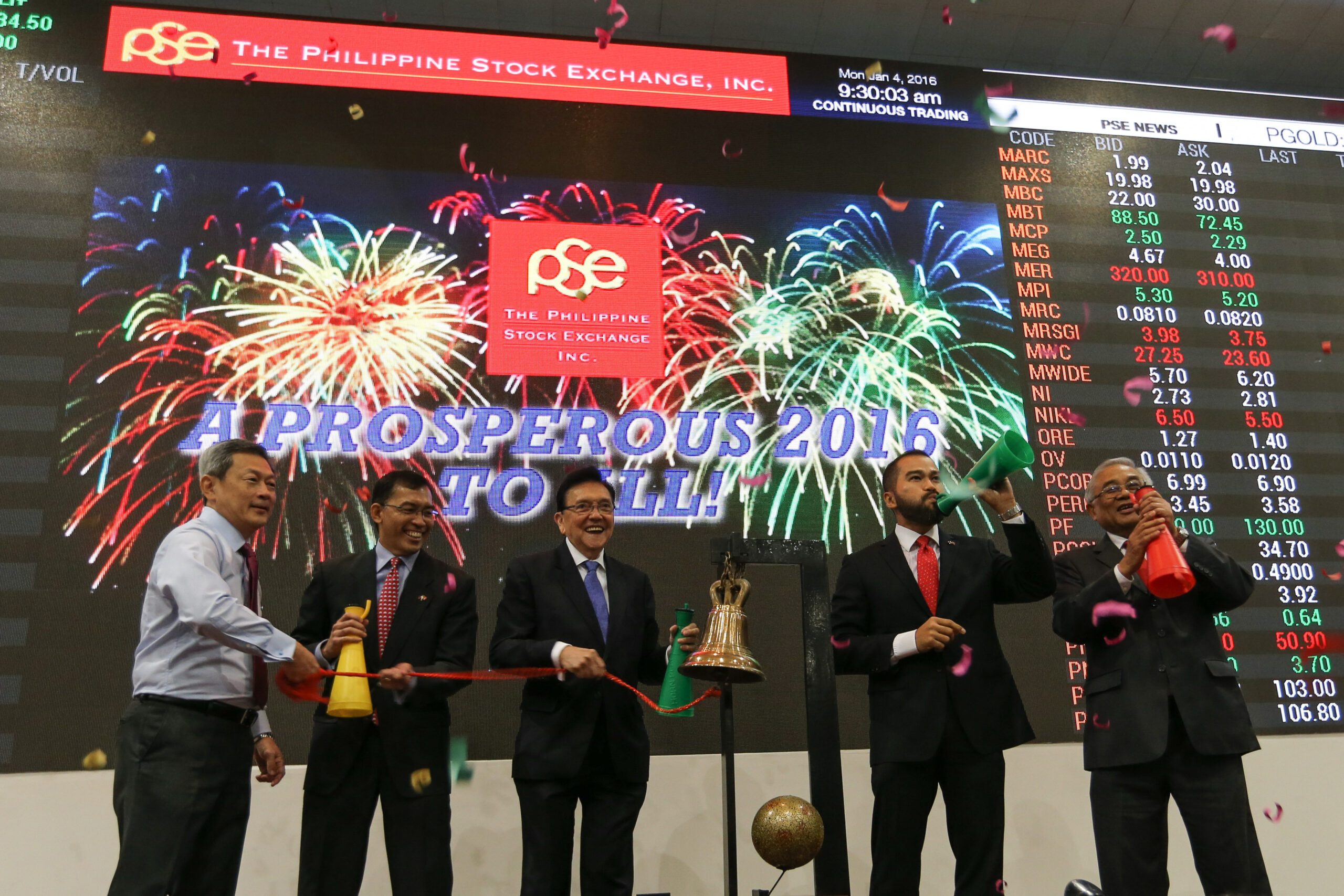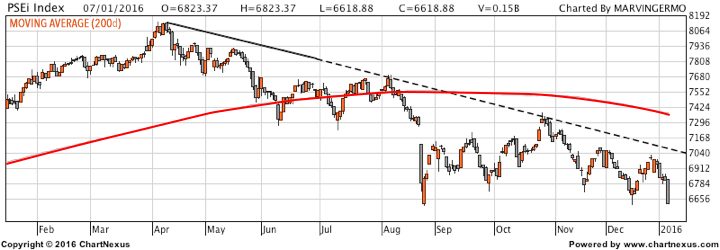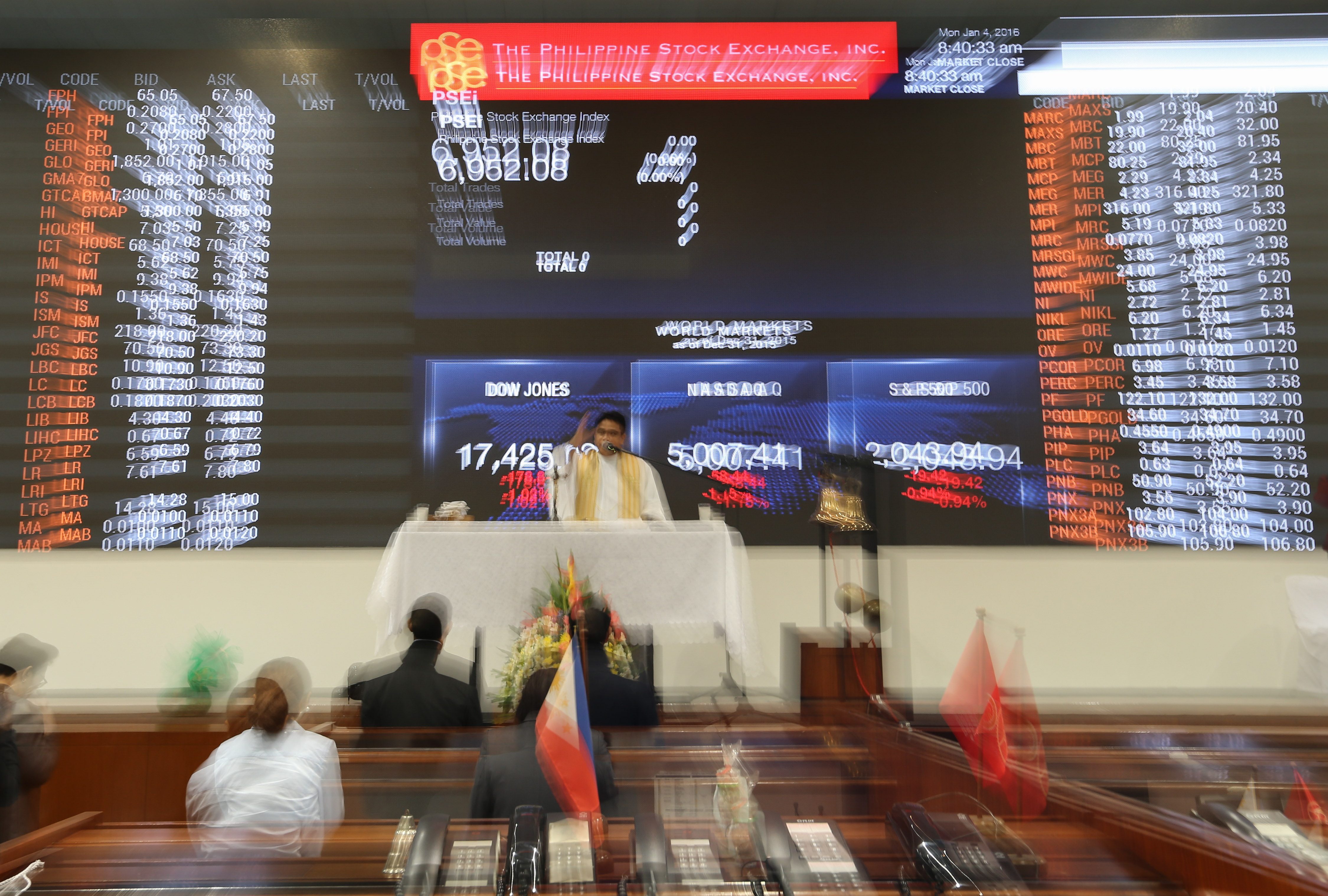SUMMARY
This is AI generated summarization, which may have errors. For context, always refer to the full article.

MANILA, Philippines – As 2016 trading year comes into full swing, we see a lot of things different in the market from where we were a year ago.
Last year, the Philippine Stock Exchange Index (PSEi) opened up with so much optimism and as it was riding up a very steady uptrend which eventually brought it to its highest close of 8,127.48. (READ: The preferred consumer stocks in 2015)
However, after hitting that mark, the market started to reverse and is currently now on an 8-month downtrend, leaving investors worried, especially those who are relatively new to stocks, hurting with losses. (READ: A rough 2015 for PH stocks)
As of this writing, the PSEi is now at 6,618, which is -18.6% down from its peak last year. Looking at it from a global perspective, there are a lot of fears abroad that have brought uncertainty to our market.
Major concerns
One of the major concerns though is the slowdown of China, which for the past few months has been hit by a barrage of not so good economic data. Its slowdown has also played part in the commodities slump that we are seeing as of late.
Another cause of concern is the fear of oil prices going much lower. Lower oil prices will be very beneficial to the Philippines since we do not produce our own oil and have to buy it in the world markets, but the issue is how this drop in oil prices affects other oil producing countries that for years have relied so heavily on oil exports.
At this moment, we are already seeing some companies in the Gulf region taper off on projects and some layoffs have already started. If this progresses further, this may also endanger the jobs of overseas Filipino workers working in the Middle East.
On a technical aspect, I believe that our market would continue to go down as long as we are still in what chartists call a “downtrend.”
Similar to my update in August, it should not surprise us if we see the market continue to go down until we see a reversal in sight. (READ: Keep calm when buying, selling stocks)
As of this writing, a reversal is not yet in sight. If you check the chart below, I would call it a successful reversal if the market successfully breaks past 7,140 and the 200-day moving average (orange line) upward.

Until that time comes, all of the bad news abroad will only add fuel to what is already a market dominated by sellers and anxiety.
Failing market
With that, what should you do in a falling market?
Mind you, while this is going on, the dynamics of the Philippines and its growth prospects still remain intact. Our country still remains to be a consumption-driven economy; we still are in a low inflation and low interest environment; and our business process outsourcing industry still is poised to grow leaps and bounds each year. In short, our fundamentals still remain good.
On a valuation basis, one thing to consider though is in spite of the market dropping significantly, our P/E ratio is still at 19x. For those who are new to stocks, the P/E ratio is a relative valuation ratio that measures the price of a stock/index compared to its earnings per share.
What you need to know is the higher the P/E ratio of the PSEI, the market is relatively expensive and the lower its value, the relatively cheaper it is. The thing is, when you compare the PSEI with other markets in our region, we are still relatively more expensive.
As such, as an investor, it is best to manage your expectations because:
- The market is still on a downtrend with no signs yet that it is about to reverse.
- Even if the PSEi has dropped over the past few months, it still is relatively expensive.
- In spite of it going down and is still expensive, the country’s growth prospects still remain intact and good.

Your options
Should the market continue to go lower in 2016, stocks that have great growth stories and have a good track record of earnings can be bought at a much cheaper price.
You could use this extended period of the market dropping as a time to store loads of cash, so that you can come in when stocks that you have pre-selected to watch have run its course and have started to bounce back upward.
The key in this market is to be very selective: Pick the ones that have been battered the most, the ones that have a huge upside potential, and pick them up once they have stopped falling. I suggest that you maintain a watch list of stocks that have passed your analysis that you can faithfully monitor.
For those who do not use technical analysis and use peso cost averaging to determine when to buy, continue to stick to your plan, and keep on buying the stocks that you have pre-determined to buy every month.
The reason why you are using peso cost averaging is because you have a relatively longer timeframe in the market and your goal is to accumulate as much shares as you can of fundamentally sound companies. This movement downward can be an opportunity for you to buy more shares at a relatively cheaper price.
But if you are conservative and yet still want to invest in stocks, then preferred shares are for you. These stocks would give you a fixed percentage of dividends, even if the market is volatile. Preferred shares would give you the stability as compared to common shares that undergo the day to day beating of the market.
If you want a bit of action but still want a sense of relatively-fixed earnings, then consider high-dividend paying stocks with low beta (beta is the measure of the stock’s volatility). The lower the beta (beta less than 1), the lesser the volatility of the stock.
So look for stocks with a beta below 1. This may not be as exciting but you get protected from wild downward swings that may happen, earn from the dividends, and you can still earn from capital appreciation should the stock reverse upward later on.
The best way to lose in this market is to base your decisions on fear and panic. I hope this helps you create a strategy on how you compose your buying and selling.
If you were hit by losses, use this as a time to reflect and build on those mistakes.
Stock investing is not about playing a perfect game but rather knowing when you have lost, making the adjustments, and winning more later on. – Rappler.com
 Marvin Germo is a registered financial planner, a bestselling author, personal finance consultant, and a stock market trader and investor. He has around 8 years of experience in the Philippine financial industry. He specializes in technical analysis and position trading. Read his blog. Follow him on Twitter: @marvingermo
Marvin Germo is a registered financial planner, a bestselling author, personal finance consultant, and a stock market trader and investor. He has around 8 years of experience in the Philippine financial industry. He specializes in technical analysis and position trading. Read his blog. Follow him on Twitter: @marvingermo
Add a comment
How does this make you feel?
There are no comments yet. Add your comment to start the conversation.